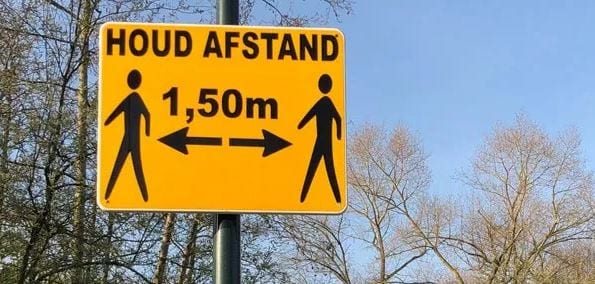One and a half meter retail - how realistic is that?
For the time being, the corona measures are only being relaxed more slowly and the concept is being extended one and a half meter society is very successful to become the new word of 2020. What does this mean for the retail industry, which will be hit the hardest together with the catering industry? In retail, the doors are opening slowly again. Responsible shopping as a guideline with the Protocol. The second provision states that the retailer must ensure that customers and staff must be able to maintain a distance of at least 1.5 meters from each other. But how realistic is one and a half meter retail?
It is clear that a lot will change. But there is still a lot of confusion and uncertainty, as is apparent from the many entrepreneurial questions that INretail is fired at on a daily basis. The association for (online) shops in the non-food sector mainly answers questions about financial challenges and bridging measures. In addition, questions about restarting the business are increasing. An important question is: how do we increase the turnover per square meter? It is a logical question, because within the 'new normal' a lot of retail space suddenly remains unused.
The government will remain strict to prevent a second wave of contamination from occurring soon when everything loosens again. So it is expected to be retail activity protocol will remain in effect for a while. In addition to the one and a half meter directive, the regulation also stipulates that shops may allow a limited number of customers at a time. The guideline is: a maximum of one customer per square meter of retail space. In short: it will become considerably emptier and quieter in the physical store.
Experience seems taboo in one and a half meter retail
There is another reason why everything changes. Has been for years on end experience the holy grail that should give the physical store the right to exist. Preferably within a good omnichannel strategy. The shop as a testing ground, as the place to feel, smell and try on products. The government is also putting an end to that for the time being. An important provision for the one and a half meter retail is: take samples, tastings, samples and trial items from the store and put not in on experience. So it is not only getting emptier and quieter in the store, but also more boring and impersonal.
To illustrate: the time when a friendly employee comes to help fit or spray a test bottle of perfume on the inside of your wrist to experience the fragrance seems to be over. In addition, employees at the checkout and ATM will disappear behind perspex screens for the time being. Finally, especially in the fashion industry there is a chance of empty shelves, which is also not conducive to shopping pleasure. On the one hand, the production of the autumn collections is virtually stopped in countries such as China, Italy and Bangladesh. On the other hand, small retailers in particular lack sufficient cash to buy new stock and insuring supplier credits is more difficult.
One and a half meter retail leads to a shortage of supply
In addition to the fact that the one and a half meter retail causes the army to become less pleasant and impersonal in the physical store, researchers expect more changes. McKinsey & Company and BoF (businessoffashion.com) recently put together a series of predictions The State of Fashion 2020 - Coronavirus Update. It is an important indicator, because in larger retail concentrations, fashion shops are the trendsetters and trendsetters. Based on the international update, we can expect this:
- the offer becomes more seasonal and leaves the stores more dosed;
- the number of sales moments and stunts is decreasing, so that retailers can achieve better margins (there is even an increasing call for a sale law);
- sales spikes in the tourist season are now a thing of the past, as travel is curtailed;
- smaller players will disappear even more from the range of shops, large and wealthy chains are pulling the longest;
- there will be more emphasis on collections that are produced sustainably and preferably locally.
Low consumer confidence requires creative entrepreneurship
In the meantime, consumers are also increasingly concerned about their financial future. Or rather: deep to care. According to recent figures from Statistics Netherlands, consumer confidence reached a dramatic low in April 2020. It plunged from minus 2 in March - even if not rosily - to minus 22. That is an unprecedented sharp drop. Since consumer confidence is an important barometer for the economy in general, this does not bode well. Retail, both offline and online, will certainly notice if the consumer keeps his hand on the money and postpones larger purchases.
Where consumer confidence is declining, the importance of creative and distinctive entrepreneurship is increasing. For example, the current situation can be a good reason to give extra gas in the field of, for example, customer loyalty and further personalization of the customer journey through the use of a Customer Data Platform. It also never hurts to critically review the performance of your platform or to delve into the benefits of a centralized database for collecting, analyzing and applying relevant customer data. In short, there is plenty of work for inventive entrepreneurs in light of the one and a half meter retail.


